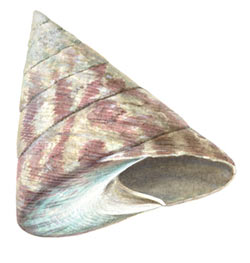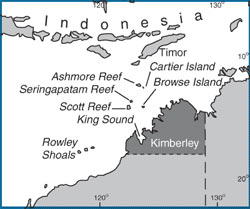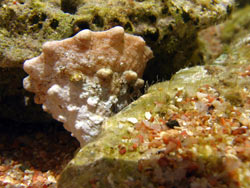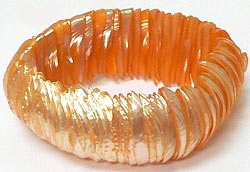Mariculture in Western Australia
Trochus Shells
For more information see www.fish.wa.gov.au/docs/aqwa/Trochus/index.php?0308
Trochus (top snails) is a genus of medium-sized to very large sea snails. They are marine gastropod molluscs and are herbivores, eating up the broken down remains of larger organims and many species of coralline and fleshy algae.. Trochus niloticus, farmed in WA, is cone shaped, has external mottled red-green and white bands and grows up to 13 cm in length. It has a very thick inner layer of nacre. The nacre is material produced by some mollusks as an inner shell layer; it is also what makes up pearls. It is very strong, resilient, and iridescent (changes colour when seen in different lights or from different angles).
This species is commercially exploited to make mother of pearl buttons, mother of pearl beads, pendants, etc for highly priced garments. The current global demand for trochus shell is estimated at 7,000 tonnes annually, worth about A$50 - $60 million. Due to an increasing value and demand for shell, trochus stocks on many reefs in Australia and the Indo-Pacific have been over-exploited. |

|
| |
|
Trochus are found in two tropical regions of Australia- the Great Barrier Reef and the Torres Straits Islands, off the coast of north Queensland; and in Western Australia where trochus are found on coral reefs of the Buccaneer and Bonaparte Archipelagos in the Kimberley and offshore at Rowley Shoals, Browse Island, Scott Reef, Seringapatam Reef, Ashmore Reef and Cartier Island.
On the remote offshore reefs of WA, trochus are fished for by Indonesian fishers under a Memorandum of Understanding (MOU) signed between the Republic of Indonesia and the Commonwealth of Australia in 1974. Under the MOU, only sailing vessels are allowed into the zone.
On inshore reefs, trochus are collected by the Bardi Aboriginal community from One Arm Point and other communities living along the coastal region of King Sound. The export of the shell provides a valued income for these communities, while the meat is eaten locally. |

|
| |
|
Annual harvests in recent years declined drastically to less than 15 tonnes, compared to about 50 tonnes a decade ago and 135 tonnes in 1980. A great deal of research into producing juveniles and improving trochus fisheries, has been carried out in collaborative projects involving Australian and overseas scientists.
Breeding stock are collected from intertidal reefs and can be made to spawn all year round. Young trochus will be produced on a commercial scale in the Multi-Species Hatchery currently being built in Broome for the Kimberley Aquaculture Aboriginal Corporation.
The young trochus, fed on microalgae, are removed from hatchery tanks and released onto reef sites when they are about two months old (less than 3 mm in diameter). The young shells are highly vulnerable to predators including fish, mantis shrimp, crabs and octopus. Other organisms such as copepods, limpets, boring sponges and boring bivalves can damage their shells, reducing their value. Growing them in strong cages until they are 4 cm in diameter reduces these problems greatly.
In summary, there are three methods to enhance trochus fisheries
- Move breeding stock to areas with few trochus to prevent them from being fished for.
- Release large numbers of small hatchery-produced juveniles. High losses to predators is the majot problem with this method.
- Release large juveniles after a longer time in the nursery into cages on reefs. Major problems are high costs, insufficient food supply and storm damage to cages.
|


|
|
|